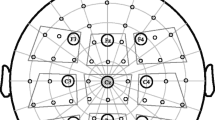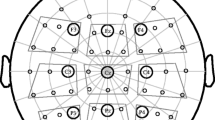Abstract
Evoked brain potentials were used to monitor moment-by-moment decisions during language comprehension. Subjects read sentences containing temporary syntactic ambiguities for which one of the possible interpretations was semantically implausible. The N400 component of the evoked potential, which is sensitive to implausibility, was used to discover when during a sentence subjects made a decision about the ambiguity. The results demonstrate that readers try to interpret a syntactic ambiguity early in a sentence rather than waiting for disambiguating information. This introduces a new way to use brain activity to study sentence comprehension processes.
Similar content being viewed by others
References
Besson, M., & Macar, F. (1987). An event-related potential analysis of incongruity in music and other non-linguistic contexts.Psychophysiology, 24, 14–15.
Boland, J., Tanenhaus, M.K., & Garnsey, S.M. (1989).Evidence for the immediate use of verb control information in parsing. Manuscript submitted for publication.
Clifton, C. Jr., & Frazier, L. (1986). The use of syntactic information in filling gaps.Journal of Psycholinguistic Research, 15, 209–224.
Clifton, C., Jr., & Frazier, L. (1988). Comprehending sentences with long-distance dependencies. In M.K. Tanenhaus & G. Carlson (Eds.),Linguistic structure in language processing. Dordrecht: Reidel.
Clifton, C., Jr., Frazier, L., & Connine, C. (1984). Lexical expectations in sentence comprehension.Journal of Verbal Learning and Verbal Behavior, 23, 696–708.
Crain, S., & Fodor, J.D. (1985). How can grammars help parsers? In D.R. Dowty, L. Kartunnen, & A.M. Zwicky (Eds.),Natural language processing: Psychological, computational, and theoretical perspectives. New York: Cambrige University Press.
Einot, I., & Gabriel, K. R. (1975). A study of the powers of several methods of multiple comparison.Journal of the American Statistical Association, 70, 351.
Fischler, I., Bloom, P.A., Childers, D.G., Roucos, S.E., & Perry N.W. (1983). Brain potentials related to stages of sentence verification.Psychophysiology, 20, 400–409.
Fodor, J.D. (1978). Parsing strategies and constraints on transformations.Linguistic Inquiry, 9, 427–473.
Fodor, J.D. (1988). On modularity in syntactic processing.Journal of Psycholinguistic Research, 17, 125–168.
Ford, M., & Dalrymple, M. (1988). A note on psychological evidence and alternative grammars.Cognition, 29, 63–71.
Frazier, L., Clifton, C., Jr., & Randall, J. (1983). Filling gaps: Decision principles and structure in sentence comprehesion.Cognition, 13, 187–222.
Jasper, H.H. (1958). The ten-twenty electrode system of the International Federation.Electroencephalography and Clinical Neurophysiology, 10, 371–375.
Kucera, H., & Francis, W.N. (1967).Computational analysis of present-day American English, Providence, RI: Brown University Press.
Kutas, M., & Hillyard, S.A. (1980a). Reading senseless sentences: Brain potentials reflect semantic incongruity.Science, 207, 204–206.
Kutas, M., & Hillyard, S.A. (1980b). Reading between the lines: Event-related brain potentials during natural sentence processing.Brain and Language, 11, 354–373.
Kutas, M., & Hillyard, S.A. (1983). Event-related brain potentials to grammatical errors and semantic anomalies.Memory and Cognition, 11, 539–550.
Kutas, M., & Hillyard, S.A. (1984). Brain potentials during reading reflect word expectancy and semantic association.Nature, 307, 161–163.
Nageishi, Y., & Shimokochi, M. (1985). The effects of semantic or grammatical incongruity on event-related potentials in Japanese.Electroencephalography and Clinical Neurophysiology, 61, S32-S33.
Polich, J. (1985a). Semantic categorization and event-related potentials.Brain and Language, 26, 304–321.
Polich, J. (1985b). N400s from sentences, semantic categories, and number and letter strings?Bulletin of the Psychonomic Society, 23, 361–364.
Ryan, T.A. (1959). Multiple comparisons in psychological research.Psychological Bulletin, 56, 26.
Stowe, L.A. (1986). Parsing WH-constructions: Evidence for on-line gap location.Language and Cognitive Processes, 1, 227–245.
Tanenhaus, M.K., Stowe, L.A., & Carlson, G. (1985).The interaction of lexical expectation and pragmatics in parsing filler-gap constructions. Paper presented at the Cognitive Science Society Meeting.
Tanenhaus, M.K., Boland, J., Garnsey, S.M. & Carlson, G. (1989). Lexical structure in parsing long-distance dependencies.Journal of Psycholinguistic Research, 18, 37–50.
Tanenhaus, M.K., Garnsey, S.M., & Boland, J. (1989). Argument structure and the parsing of long-distance dependencies. Manuscript in preparation.
Welsch, R.E. (1977). Stepwise multiple comparison procedures.Journal of the American Statistical Association, 72, 359.
Author information
Authors and Affiliations
Rights and permissions
About this article
Cite this article
Garnsey, S.M., Tanenhaus, M.K. & Chapman, R.M. Evoked potentials and the study of sentence comprehension. J Psycholinguist Res 18, 51–60 (1989). https://doi.org/10.1007/BF01069046
Issue Date:
DOI: https://doi.org/10.1007/BF01069046




